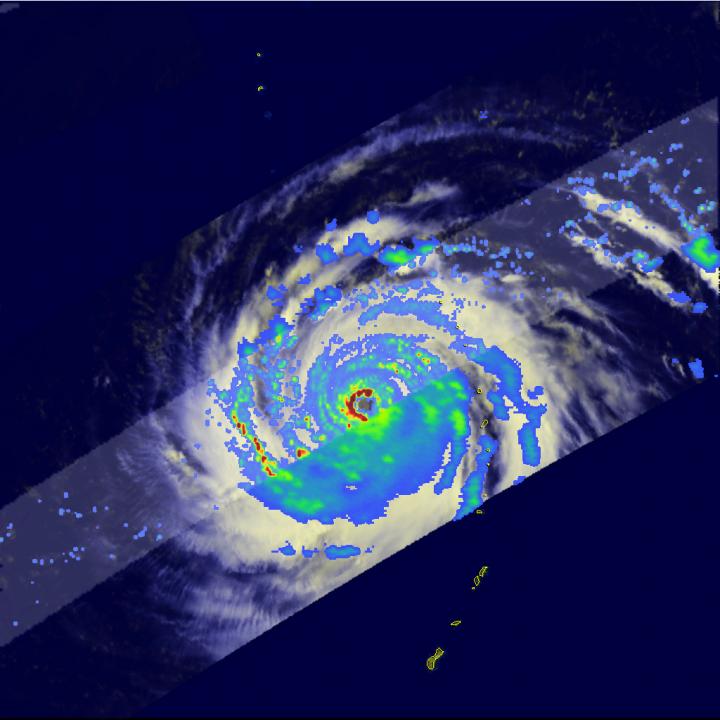Typhoons rain away wrath

Heaviness of rainfall around the typhoon's center is marked by red, green and blue in that order. Areas with the heaviest rainfall, in red and green are around the central column. The Tropical Rainfall Measuring Mission (TRMM) satellite which captured the image is a joint mission between NASA and JAXA. Credit: NASA Earth Observatory.
Researchers at the Okinawa Institute of Science and Technology Graduate University (OIST) have found that an aspect of a typhoon being ignored by current forecasting models plays a significant role in determining the level of havoc it will wreak upon landfall.
Typhoons dump a lot of water in the form of rain. The researchers have demonstrated that the energy lost to friction between this falling rain and the whipping winds of a typhoon can lessen the typhoon's destructive force, or intensity, by as much as 30 percent.
The paper, authored by researchers from OIST's Fluid Mechanics Unit and Continuum Physics Unit, appeared online in Geophysical Research Letters.
The intensity of a typhoon is set by the wind speed at the base of the typhoon's central column. To predict this speed, scientists currently model typhoons as engines fueled by heat from the ocean water.
Heat is carried away from the ocean surface by hot water vapor. This vapor is collected by the spiraling winds of the typhoon and tossed up along the typhoon's central column. As it moves away from the warmth of the ocean, it cools back to water and falls as rain. In the typhoon's central column itself this rainfall amounts to some 2 trillion liters of water per day, which is comparable to a large river falling out of the sky.
“The pace at which energy is lost to friction between rain and winds in a single typhoon would be sufficient to keep the Japanese economy running,” said Tapan Sabuwala from OIST's Continuum Physics Unit, the first author of the paper.
The OIST researchers compared their predictions of typhoon intensity to satellite data compiled over the past thirty years and found that the margins of error between prediction and observation reduced significantly when the friction between rain and winds was factored in.
“For this study we used a simple mathematical model. We are now looking into state-of-the-art models that people use for actual forecasting,” said Pinaki Chakraborty, head of OIST's Fluid Mechanics Unit.
Climate change is increasing ocean temperatures worldwide. This is expected to lead to stronger typhoons. Predicting their intensities accurately will be crucial to anticipating damages and minimizing loss of lives. The OIST research is a major step in this direction.
Media Contact
All latest news from the category: Earth Sciences
Earth Sciences (also referred to as Geosciences), which deals with basic issues surrounding our planet, plays a vital role in the area of energy and raw materials supply.
Earth Sciences comprises subjects such as geology, geography, geological informatics, paleontology, mineralogy, petrography, crystallography, geophysics, geodesy, glaciology, cartography, photogrammetry, meteorology and seismology, early-warning systems, earthquake research and polar research.
Newest articles

NASA: Mystery of life’s handedness deepens
The mystery of why life uses molecules with specific orientations has deepened with a NASA-funded discovery that RNA — a key molecule thought to have potentially held the instructions for…

What are the effects of historic lithium mining on water quality?
Study reveals low levels of common contaminants but high levels of other elements in waters associated with an abandoned lithium mine. Lithium ore and mining waste from a historic lithium…

Quantum-inspired design boosts efficiency of heat-to-electricity conversion
Rice engineers take unconventional route to improving thermophotovoltaic systems. Researchers at Rice University have found a new way to improve a key element of thermophotovoltaic (TPV) systems, which convert heat…



